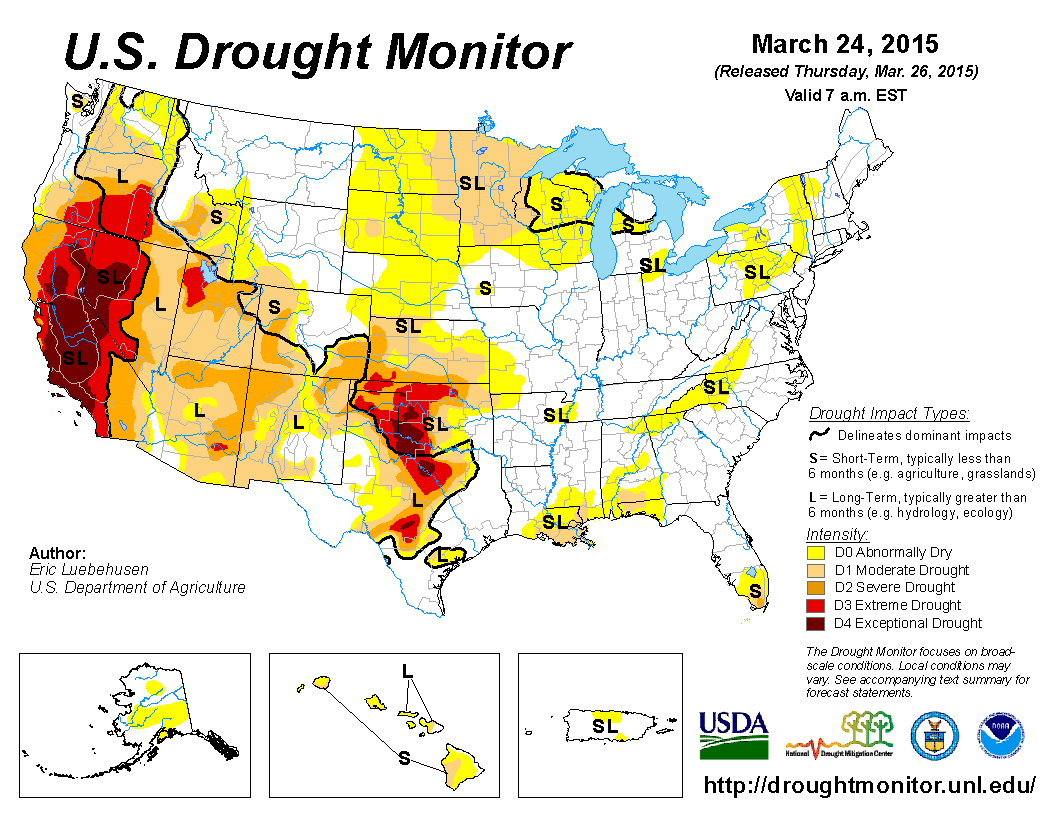The historic and ongoing drought in California is getting harder to ignore in terms of its potential impact on the US economy down the road. The Golden State, after all, boasts the country’s largest GDP among the 50 states, representing a bit more than 13% of US output, based on 2013 data via the US Bureau of Economic Analysis. That’s well above the nearly 9% share for Texas, the second-biggest state economy. But as the dry spell persists, now in its fourth year, it’s reasonable to wonder if California’s growth prospects will suffer. In turn, if the biggest state wilts due to drought, what are the implications for the US?
At the moment, it’s hard to say. The drought-inflicted pain so far has been minimal in terms of the broad macro trend for the state. On a US level, it’s virtually undetectable. Meantime, this month’s UCLA Anderson Forecast for California “calls for continued steady gains in employment through 2017.” The group’s senior economist, Jerry Nickelsburg, says that “the increase in U.S. growth rates from construction, automobiles, and business investment, as well as higher consumer demand, will continue to fuel our local economy.”
The question, of course, is how or if this relatively rosy view could change if the drought rolls on? It’s hard to estimate this risk with any accuracy at this stage, but it’s fair to say that the potential for trouble is inching upward. A recent report from scientists writing for the online journal ScienceAdvances warns of an “unprecedented 21st century drought risk in the American Southwest and Central Plains.”
Scientific hyperbole? Maybe, but the longer the drought persists, the higher the risk of macro blowback in some degree. The immediate challenge is the dwindling resources for generating power from water. “For the areas of the state that have been able to rely on inexpensive hydro, and then they have to purchase more expensive energy off the grid — those costs are an impact that will be passed along over time,” says Robert Oglesby, executive director of the state energy commission. Not surprisingly, “the drought has led to a direct increase in electricity costs to California ratepayers,” notes a new study from the Pacific Institute. The bottom line: the fading water supply has cost California $1.4 billion so far, the group estimates.
By some accounts, California’s reservoirs have been reduced to roughly a one-year supply. That doesn’t mean that the water will literally run out in a year, but it’s a stark reminder that the clock is ticking. The solution, of course, is precipitation… lots of it. But that’s nowhere on the horizon, at least in quantities that will make a difference any time soon. Or so current projections advise. In the meantime, there’s a guessing game about what it all means in economic terms and how long the dry spell will last.
As for where we stand at the moment, here’s a short list of resources for getting up to speed on drought risk in the American West:
● How Bad Is California’s Drought? Hint: it’s pretty bad | Smithsonian
● The Economics of California’s Drought | The Atlantic
● How California’s Constant Drought Will Affect the World | Liberty Voice
● What if California’s drought is permanent? | Sacramento Bee
● Intensifying Calif. drought sets off economic alarms | USA Today
● Will California’s drought affect hydroelectric power? | CSM
● Drought & Double-Digit Unemployment In Cities | 24/7 Wall Street
● Drought creeps into economic forecast | Hanford (CA) Sentinel
● Calif. has about 1 year of water stored. Will you ration now? | LA Times
● Californians Say Neighbors Lax On Drought Response | Public Policy Inst. of Calif.
● CaliforniaDrought.org | Pacific Institute

Source: US Drought Monitor
Pingback: The Impact of the Drought in the West